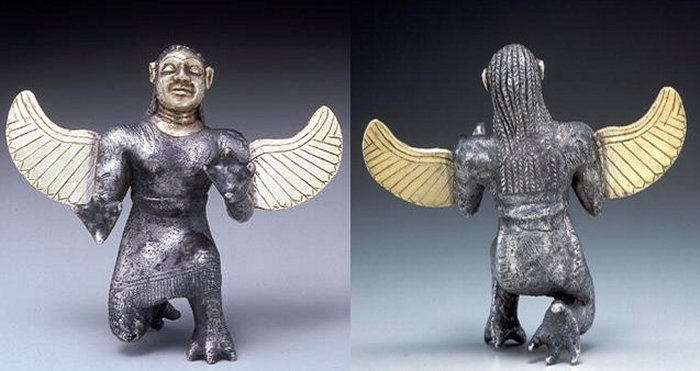Unusual Ancient Winged Half-Human And Half-Animal Divine Creature With Supernatural Powers
Conny Waters - AncientPages.com - This unusual figure is unique in many ways. It represents a winged half-human and half-animal creature credited with supernatural powers. It is made of silver and electrum and dates back to the latter half of the 3rd millennium B.C.
Unusual winged half-human and half-animal creature. Image credit: Miho Museum
The figure is about 12 cm high up to the top of the head.
As you can see, this being squats with his left knee up, directs his face slightly upward, and extends his arms forward. A pair of large electrum wings with engraved sword-shaped feathers emerge from each side of his upper arms. Each limb has four talons at its end.
The figure's hair is shown in tufts with a herringbone-like pattern over its back. A thin electrum sheet covers the face, with the forehead and ears.
The small electrum figure sits straight, with firmly folded hind limbs, with both legs shown to the right and left. Each limb has a hoof of the ungulate type at its end. The figure's right arm is held up with the hoof's bottom directed forward, while its left arm is held with the bottom of the hoof directed toward the abdomen.
The head has two three-forked ox-like horns, and slightly wavy hair is parted in the middle and hangs over the back.
Winged bull with human head-AO 19859. Unknown author. Louvre Museum - Image credit: 0x010C -CC BY-SA 4.0
Based on current archaeological discoveries, no similar example of this horn type is known yet. It shouldn't be dismissed that a threefold horn or horn tassel may have been intended.
There are, however, examples of similar statues representing the Mesopotamian style in southern Iran. One of them is a small copper figure of the 3rd millennium B.C., which derives from Elam.
The creature is slightly similar to the lamassu, an Assyrian protective deity, often depicted as having a human's head, a body of an ox or a lion, and bird's wings.
The squatting or straight posture in figures wearing large girdles and kilts is found mainly in southeastern Iran's cylinder seals and stone vessels. It is not unusual to encounter representation of the hair in the silver figure of Eastern Iranian art. Half-naked figures are also commonly seen in ancient West Asian art.
Written by Conny Waters – AncientPages.com Staff Writer
Updated on April 20, 2023
Copyright © AncientPages.com All rights reserved. This material may not be published, broadcast, rewritten or redistributed in whole or part without the express written permission of AncientPages.com
More From Ancient Pages
-
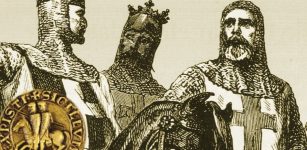 Knights Templar – Among The Most Wealthy And Powerful Of The Western Christian Military Orders
Featured Stories | Jun 11, 2020
Knights Templar – Among The Most Wealthy And Powerful Of The Western Christian Military Orders
Featured Stories | Jun 11, 2020 -
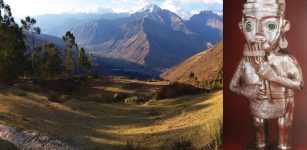 Ancient Underground Tombs And Lightening God In Peru – Complex Concepts Of Death And Renewal Revealed
Archaeology | May 22, 2018
Ancient Underground Tombs And Lightening God In Peru – Complex Concepts Of Death And Renewal Revealed
Archaeology | May 22, 2018 -
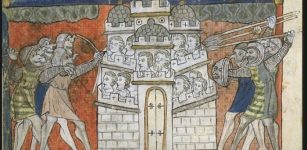 Gog And Magog Prophecy In The Book Of Revelation
Biblical Mysteries | Oct 11, 2018
Gog And Magog Prophecy In The Book Of Revelation
Biblical Mysteries | Oct 11, 2018 -
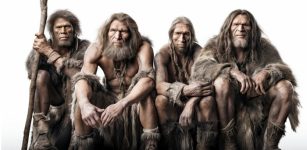 Neanderthals Cared For Each Other And Survived Into Old Age – Study Shows
Evolution | Nov 2, 2023
Neanderthals Cared For Each Other And Survived Into Old Age – Study Shows
Evolution | Nov 2, 2023 -
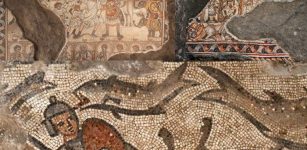 World’s Oldest Mosaics Of Biblical Jonah And The Whale Discovered
Archaeology | Jul 23, 2017
World’s Oldest Mosaics Of Biblical Jonah And The Whale Discovered
Archaeology | Jul 23, 2017 -
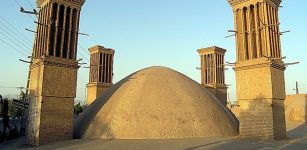 Remarkable Ancient Windcatchers: Air Conditioning Systems Built Since Antiquity
Ancient Technology | Sep 3, 2016
Remarkable Ancient Windcatchers: Air Conditioning Systems Built Since Antiquity
Ancient Technology | Sep 3, 2016 -
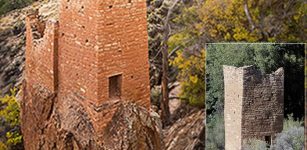 Ancient Ruins Of Hovenweep: Impressive Puebloan Masonry
Civilizations | Mar 15, 2016
Ancient Ruins Of Hovenweep: Impressive Puebloan Masonry
Civilizations | Mar 15, 2016 -
 Mystery Of Saint Brendan’s Island – Glimpses From An Alternate Reality, Fata Morgana Or A Submerged Land?
Featured Stories | May 6, 2023
Mystery Of Saint Brendan’s Island – Glimpses From An Alternate Reality, Fata Morgana Or A Submerged Land?
Featured Stories | May 6, 2023 -
 All 5 Genetic ‘Letters’ Of DNA May Have Been Brought By Meteorites To Ancient Earth
DNA | May 21, 2022
All 5 Genetic ‘Letters’ Of DNA May Have Been Brought By Meteorites To Ancient Earth
DNA | May 21, 2022 -
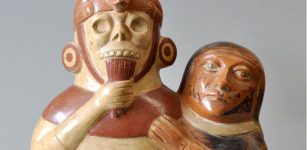 South American Musical Instruments Reflect Population Relationships – Archaeological Records Reveal
Archaeology | Sep 20, 2021
South American Musical Instruments Reflect Population Relationships – Archaeological Records Reveal
Archaeology | Sep 20, 2021 -
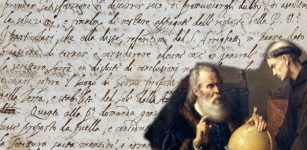 Galileo Galilei’ Long-Lost Letter Reveals His Attempt To Fool The Inquisition And Make Science Independent From Religion
Archaeology | Sep 22, 2018
Galileo Galilei’ Long-Lost Letter Reveals His Attempt To Fool The Inquisition And Make Science Independent From Religion
Archaeology | Sep 22, 2018 -
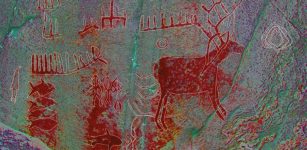 Tumlehed Rock Art And Seafaring In Stone Age’s Sweden
Archaeology | Nov 11, 2019
Tumlehed Rock Art And Seafaring In Stone Age’s Sweden
Archaeology | Nov 11, 2019 -
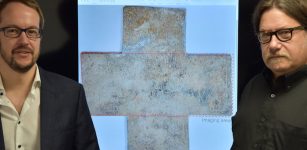 Terahertz Imaging Reveals Hidden Inscription On Early Modern Funerary Cross
Archaeology | Apr 26, 2022
Terahertz Imaging Reveals Hidden Inscription On Early Modern Funerary Cross
Archaeology | Apr 26, 2022 -
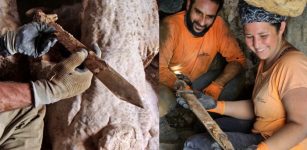 Four Rare And Incredibly Well-Preserved 1,900-Year-Old Roman Swords Found In Judean Desert
Archaeology | Sep 6, 2023
Four Rare And Incredibly Well-Preserved 1,900-Year-Old Roman Swords Found In Judean Desert
Archaeology | Sep 6, 2023 -
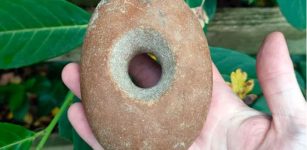 Mesolithic Stone Mace Head Found Near Buckingham, UK
Archaeology | Apr 7, 2023
Mesolithic Stone Mace Head Found Near Buckingham, UK
Archaeology | Apr 7, 2023 -
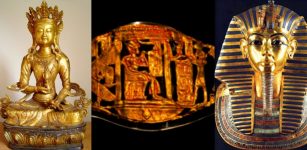 Ancient Sophisticated Technologies: Mercury-Based Gilding That We Still Can’t Reach
Ancient Technology | Aug 1, 2018
Ancient Sophisticated Technologies: Mercury-Based Gilding That We Still Can’t Reach
Ancient Technology | Aug 1, 2018 -
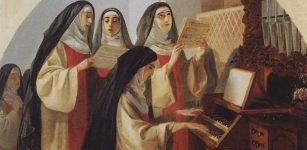 Medieval Music Wasn’t Only Supposed To Be Beautiful To Listen To – A New Study Suggests
Archaeology | Jun 8, 2023
Medieval Music Wasn’t Only Supposed To Be Beautiful To Listen To – A New Study Suggests
Archaeology | Jun 8, 2023 -
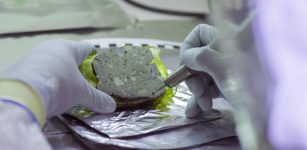 How Is DNA Preserved In Archaeological Sediments For Thousands Of Years
Archaeology | Jan 3, 2022
How Is DNA Preserved In Archaeological Sediments For Thousands Of Years
Archaeology | Jan 3, 2022 -
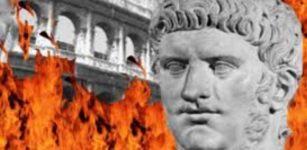 On This Day In History: Most Notorious Roman Emperor Nero Committed Suicide – On June 9, 68 AD
News | Jun 9, 2016
On This Day In History: Most Notorious Roman Emperor Nero Committed Suicide – On June 9, 68 AD
News | Jun 9, 2016 -
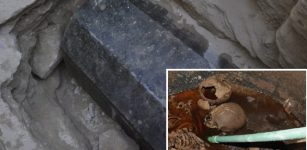 Thousands Want To Drink Red Liquid From The Granite Sarcophagus In Egypt
Archaeology | Jul 23, 2018
Thousands Want To Drink Red Liquid From The Granite Sarcophagus In Egypt
Archaeology | Jul 23, 2018

